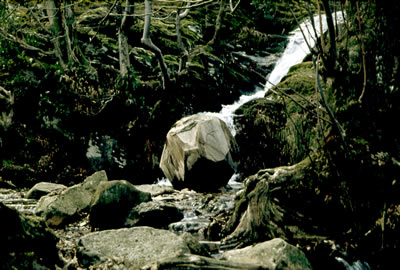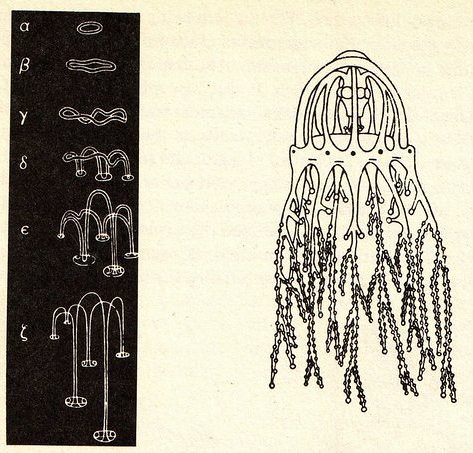Viewpoint by Tania Kovats a concrete sculpture from 1998 located beside Keilder Water in Northumberland
image via Geograph
nature
Viewpoint by Tania Kovats a concrete sculpture from 1998 located beside Keilder Water in Northumberland
image via Geograph
I've posted before about Hilary Berseth's sculptures which he makes by placing armatures into bee hives but the 3B Printing Project takes this a step further by using 3B printed moulds. It's an ad for honey but worth a look anyway. The first minute of the video is about beekeeping, the sculpture part starts after that. via Make
This video features selections from the the documentary, Proteus
The chromatophores in a squid stimulated by Cypress Hill's Insane in the Membrane.
More info here

"He (David Nash) first carved a rough sphere... and intended to take this back to his studio. However, access was up a long steep track and at 400 kg and a metre wide, this 'boulder' was dangerous to move downhill. So instead Nash used a nearby stream, where rocky banks would contain the momentum of its descent.
However, a little way down the bank, the boulder became wedged in a waterfall. Nash had no option but to leave it there. It looked good in the streaming water, and so Nash began photographing it... the journey of Wooden Boulder had begun.
The following March heavy rainfall shifted Wooden Boulder into the pool below. Still with the intention of moving it to his studio, Nash hauled it out of the stream and rolled it down the next waterfall to the pool below, where it remained for eight years. It became obvious that the Wooden Boulder belonged to the stream; over the next 24 years it moved nine times during storms, eventually floating into the River Dwyryd estuary. Nash says of Wooden Boulder, 'It is important to the narrative of this "free-range"; sculpture that its material formed and grew on the hill over two centuries. I did not take the wood up the hill. The narrative, like the material, grew organically.'
Text quoted from the Kew Gardens website
Here is a video of Nash talking about Wooden Boulder and another work
First described in army ants by Schneirla (1944). A circle of army ants, each one following the ant in front, becomes locked into a circular mill. They will continue to circle each other until they all die. How crazy is that? Sometimes they escape, though. Beebe (1921) described a circular mill he witnessed in Guyana. It measured 1200 feet in circumference and had a 2.5 hour circuit time per ant. The mill persisted for two days, "with ever increasing numbers of dead bodies littering the route as exhaustion took its toll, but eventually a few workers straggled from the trail thus breaking the cycle, and the raid marched off into the forest."
The above quote is from a post on a blog called The Ant Room. More info here
 This photo was taken from the Guatemalan Government's Flickr feed and shows a "massive, spontaneous sinkhole ("hundimiento") that appeared today in Zone 2 of Guatemala City, after overwhelming saturation of rains from tropical storm Agatha."
This photo was taken from the Guatemalan Government's Flickr feed and shows a "massive, spontaneous sinkhole ("hundimiento") that appeared today in Zone 2 of Guatemala City, after overwhelming saturation of rains from tropical storm Agatha."
More at boingboing
 Here's a video documenting the production of Tania Kovats' artwork Tree made for the Natural History Museum in London.
Here's a video documenting the production of Tania Kovats' artwork Tree made for the Natural History Museum in London.
The artwork is a slice cut from the centre of a real oak tree and was inspired by the work of Charles Darwin.
"A giant ant colony pumped full of cement,and then excavated reveals one of Mother Nature's marvellous wonders.
We've seen what these giant ant mounds look like above ground but this is an incredible view of what the structures looks like underground - which some have called a wonder of the world."
 "The researchers decided to task the slime mold with a problem human designers had already tackled. They placed oat flakes (a slime mold favorite) on agar plates in a pattern that mimicked the locations of cities around Tokyo and impregnated the plates with P. polycephalum at the point representing Tokyo itself. They then watched the slime mold grow for 26 hours, creating tendrils that interconnected the food supplies. Different plates exhibited a range of solutions, but the visual similarity to the Tokyo rail system was striking in many of them"
"The researchers decided to task the slime mold with a problem human designers had already tackled. They placed oat flakes (a slime mold favorite) on agar plates in a pattern that mimicked the locations of cities around Tokyo and impregnated the plates with P. polycephalum at the point representing Tokyo itself. They then watched the slime mold grow for 26 hours, creating tendrils that interconnected the food supplies. Different plates exhibited a range of solutions, but the visual similarity to the Tokyo rail system was striking in many of them"
There's an article in today's Irish Times about Katie Holten's Tree Museum and her upcoming show at the Hugh Lane as a part of the Golden Bough series. The Tree Museum was a public artwork that examined people's relationships to trees in the Bronx area of New York through an audio guide featuring recordings of local people. Below is a short video about the Tree Museum and the audio recordings are available through her website.
This quote from James Gleick's book Chaos: Making a New Science
Clouds are not spheres, Mandelbrot is fond of saying, Mountains are not cones. Lightning does not travel in straight lines. the new geometry mirrors a universe that is rough not rounded, scabrous, not smooth. it is a geometry of the pitted, pocked, and broken up, the twisted, tangled, and intertwined. The understanding of nature's complexity awaiting a suspicion that the complexity was not just random, not just accident. It required a faith that the interesting feature of lightning was not its direction, but rather the distribution of zigs and zags. Mandelbrot's work made a claim about the world, and the claim was that such odd shapes carry meaning. The pits and tangles are more than blemishes distorting the classic shapes of Euclidian geometry. They are often the key to the essence of a thing.

These illustrations by D'Arcy Wenworth Thompson show the shapes made by drops of ink in water (left) and the tentacles of a jellyfish (right).
They are taken from a book called Chaos: The Amazing Science of the Unpredicatable by James Gleick and originally appeared in Wentorth Thompson's book On Growth and Form 

Hilary Berseth makes sculptures with bees by placing armatures in their hives. I blogged about his work before ages ago but it has just been featured on Makezine where they've linked to this article on nymag.com which features a slideshow of images showing the process.
Someone in the comments section of the nymag article posted this link to the work Aganetha Dick who encourages bees to build honeycombs on figurines and other objects:
